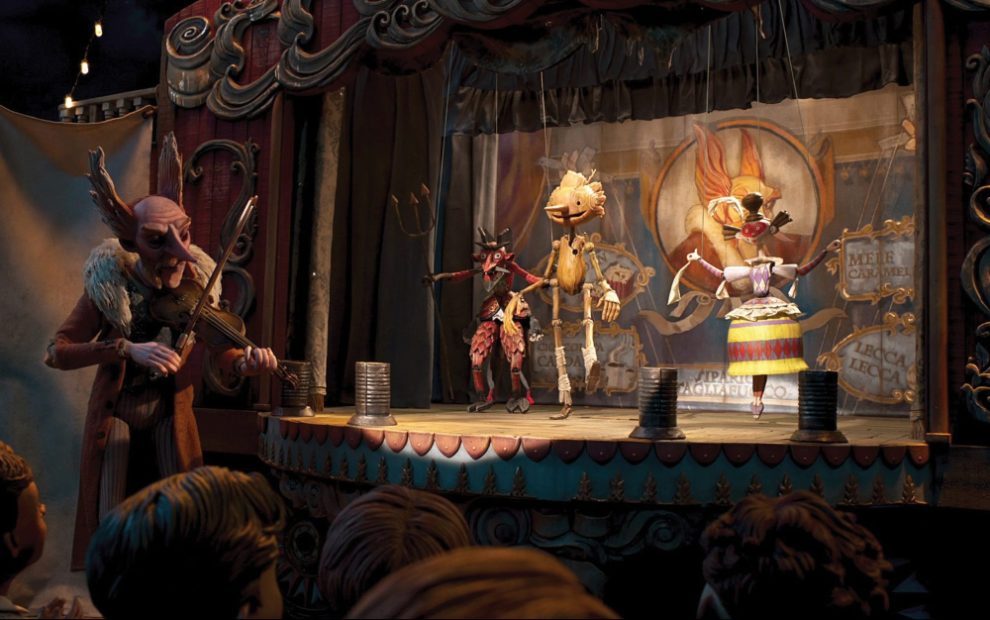What is it about an inquisitive little wooden puppet that dreams of “being a real boy” that pulls at our heartstrings? Is it his innocent wonder at the world around him? Is it the way his nose grows when he lies? Is it that he longs to be what so many of us take for granted?
And which Pinocchio captivates us? Is it Disney’s iconic puppet in red suspenders and yellow cap delightedly singing, “I got no strings on me”? Is it the much more irascible and unpredictable puppet whose adventures were originally penned in 1883 by Carlo Collodi? No less than three recent major motion pictures envision remarkably different versions of this marionette in search of humanity. These films not only showcase the creative potential of this character but also highlight important Catholic questions.
Those unfamiliar with Collodi’s original book The Adventures of Pinocchio may be in for a surprise. The book begins with Pinocchio kicking Geppetto in the nose, running away as soon as he has feet, and smashing “the talking cricket” with a hammer when the cricket tries to convince him to be kind to his father. It is clear Pinocchio has a lot to learn if shared humanity is his goal. Yet the seeds of some fundamental themes are planted that continue to captivate audiences, such as the journey from self-absorption to empathy, the relationship between fathers and sons, and how to grapple with being different.
Matteo Garrone’s critically acclaimed 2020 Italian film Pinocchio sands down some of Collodi’s rough edges while still giving us a fantastical and harrowing journey where monkeys rule in corrupt judicial courts and wayward children are turned into donkeys. It’s a world that doesn’t shy away from the harsh realities of poverty, as Geppetto, masterfully portrayed by Roberto Benigni, tries to convince Pinocchio that it’s better to live in the belly of a giant shark, because they have a place to live and fish to eat everyday.
Rarely have Pinocchio films shaped Geppetto’s story in such socially conscious terms. Early scenes of Geppetto begging for work while trying to preserve his dignity would be at home in the Italian neorealism of classic film auteurs such as Vittorio De Sica. These realist elements ground the film and help provide its depth. Here, we may initially think of the fox and the cat as purely unscrupulous villains trying to trick Pinocchio out of his gold coins, but their threadbare clothing and unkempt countenances help us realize that they too are starving and looking for their next meal.
What emerges is the cruel world that Pinocchio is born into, a theme that also stands out in Guillermo del Toro’s impressive reimagining of the Pinocchio tale. In the original story and Garrone’s film, the fox and the cat are willing to kill Pinocchio to get his gold coins and merchants are happy to sell him into a life of servitude. In del Toro’s exceptional stop-motion animation film, despite Pinocchio’s irrepressible joy at the gift of life, he is immediately faced with forces bigger than himself. The pastor of the local parish thinks he’s “an abomination”; the Podesta in Mussolini’s fascist government thinks Pinocchio is dangerous for being “an independent thinker”; and Geppetto, still reeling from the death of his first-born son, Carlo, stings Pinocchio with the unfair question, “Why can’t you be more like Carlo?”
In these cruel worlds, it’s therefore all the more touching when Pinocchio expresses love and care for others, whether it’s sacrificing himself for Geppetto as in del Toro’s version or, in Garrone’s story, escaping from the shark and carrying Geppetto to shore with the help of a large tuna. He thanks the fish with a kiss, which elicits tears. When Pinocchio asks why, the old fish poignantly responds, “Because no one has ever kissed me before.”
Pinocchio’s personality owes much to Disney’s 1940s classic, which painted a picture of Pinocchio as kind, happy-go-lucky, and infinitely curious about the world. It informed Disney’s recent live-action version of the story with Tom Hanks as Geppetto. While in that version Pinocchio’s empathy and heroic act of self-sacrifice help him discover how to be “a real boy,” in Garrone’s version, it’s adulthood that Pinocchio discovers. He not only saves Geppetto but gets a job to support the two of them in Geppetto’s convalescence, showing deep appreciation for his father. Does this mean Pinocchio conforms to societal norms? Perhaps, but he’s also learned the hardships of life.
It must also be said that Pinocchio is a puppet. It’s not lost on some of these filmmakers that puppets are often how human beings are envisioned in dictatorships. One of Mussolini’s few lines in del Toro’s impressive film is, “I like puppets.” However, due to Pinocchio’s observations about the cruel world he sees, this doesn’t end well for him. Here again, Pinocchio learns some hard lessons. Pondering the harsh realities of life, he one day looks up at the impressive crucifix in the church and asks, “Papa there’s something I don’t understand . . . he’s made of wood too . . . why do they like him and not me?” Geppetto doesn’t quite know how to respond to the comparison of Jesus to Pinocchio, but begins by saying, “People are sometimes afraid of things they don’t know.”
A basic tenet of Catholic teaching is that people are to follow their conscience. Along Pinocchio’s journey he has to make some big decisions. The wisdom of others and his own experiences bring him to name his own values. Ultimately, he’s even willing to make sacrifices for the sake of others because of these values. Sometimes it takes a puppet to show us how to be more human.
For Catholics the story of Pinocchio closes with an intriguing question: How do you feel about his transformation into flesh and blood? Of course, it’s his dream to become “a real boy,” and that can be celebrated. However, does this also register as slightly sad? After all, the face we knew is gone. His wooden nose is no more. From a Catholic sacramental perspective, material—once imbued with meaning—isn’t something to be discarded, at least not without some reverence and accompanying sadness. The wooden Pinocchio, while different than others, was no less “real” and was filled with dignity. If there’s a tinge of sadness when we see him embrace Geppetto as a “real boy,” perhaps it’s because our sacramental imagination informs us that he was a work of art the way he was made, and we’ll miss him.
This article also appears in the April 2023 issue of U.S. Catholic (Vol. 88, No. 4, pages 36-37). Click here to subscribe to the magazine.
Image: © 2022 Netflix, Inc.














Add comment